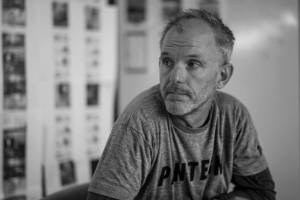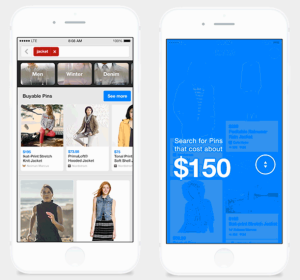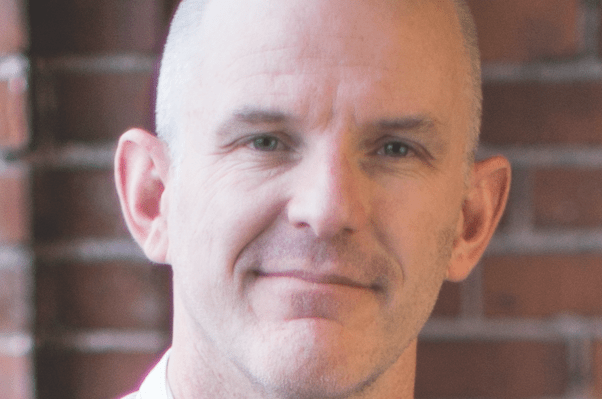About a year ago, Michael Lopp joined Pinterest as the company’s head of engineering — filling in the leadership of the engineering side next to co-founder Evan Sharp and CEO Ben Silbermann.
Much of his role, since joining, has been to help teams at Pinterest, which consist of units of engineers, designers and product managers, mesh and work well together. Lopp comes from both Apple and Palantir, where he saw environments that were focused on engineers and designers (or, in the case of Palantir, on the engineering side).
We had a chance to sit down with Lopp and hear a little bit more about what he’s up to, and how the engineering component of Pinterest has evolved since he joined.
TC: So, how are things going since you’ve joined?
Michael Lopp: Well, I’ve been here for a year and 25 days.
TC: That’s pretty specific
ML: Well when I hit a year, sort of compulsive counter, so I keep track of it. I’ll lose it in about another 30 to 60 days
I feel like it’s going really well. 60% of the team has been hired since I got here. There’s a lot of energy in the building. I dialed up new grads [hires when I first arrived]. We were tending to hire on the experienced side. There’s a good vibe in the building, and hanging out here on evenings, it’s got this good energy.
Velocity wise, it’s going really well. There are obvious things like buyable pins, but there’s lots of investment inside to get things going and stable. I look at my metrics in the morning and we’re in good shape from a technology perspective.
TC: When you mean velocity, do you mean something like code pushes?
ML: No, I’m looking more like availability [of Pinterest], incidents, the general health of the system. I don’t measure code pushes, that turns into productivity madness that drives engineers crazy, so it’s more like what is the health of the system. How are we doing, how are we growing. From a stability perspective, this is my first large internet company, but I’m in really good shape from an infrastructure perspective, I’m ahead of the curve where it should be, which is very nice.
I’m worried about my coffee intake, but otherwise things are going great.
TC: Can you tell us a little more about your background?
ML: I was at Palantir before this for about three and a half years, I was a director there, and before that I was at apple for eight and a half years, where I ran engineering for the apple store. And before that, I was running part of the Mac OS X team. I can keep going. I was part of the Netscape team a couple million years ago. I’ve been in the valley for a while.
TC: What’s the most interesting moment you’ve seen as part of your career?
ML: Actually, it’s very specific. I was at a startup you’ve never heard of. It was during that first bubble. The world was exploding, and I was sitting in a bar with my CEO and could smell that the company [was having problems]. I knew the money situation, and I got a call from a good friend, a recruiter from Apple. He called and said, ‘hey do you wanna work at Apple?’ And I was like, I wanted to work at Apple since I was a kid, so I was like, yeah! My CEO was like, who are you talking to?
I really had wanted to work at Apple forever. I went to Apple when it was kind of creeping up, the iPod was just out but it wasn’t a thing yet. It was like, well that’s interesting, it seems like they have something figured out there. I got there and the store had just come out. I went to do it to hide for like three years, and wait until the nuclear winter was over. It was one of the most successful parts of my career so far. Who would have known?
TC: Do you have a similar story for Pinterest?
ML: It’s actually very similar. I was down in Australia down there, and I got a call from Aubrey Obata Kendall, who was running recruiting at the time. And she was like, ‘I know you’re happy’ — she was at Apple with me — ‘but we have this very Lopp-shaped role here. This is perfect for you.’ I was really happy, running around the world.
It was exactly what i wanted to be doing with my career. It was kind of the same thing, I was on the phone and it was like wow, this is exactly right. I love my job right now, but there’s this opportunity ahead of me. Long story very short, about 3-4 months later I was here.
 TC: What are some of the management principles you’ve brought to Pinterest?
TC: What are some of the management principles you’ve brought to Pinterest?
ML: It’s gonna sound like I’m lazy but I swear I’m not lazy. My job is to my get myself out of a job. I’m aggressively pushing things I think I could be really good at and should actually maybe own to someone else who’s gonna get a B at it, but they’re gonna get the opportunity to go do that. My job is to — it sounds like I just want to sit here and drink coffee and talk about bread — but it’s about pushing it down so these things [to other people who] naturally come to me. Because I’m the head of engineering, I’m always looking at, does this legit need to be on my list. Should I be doing this, or is this something I can give to someone else and they should be actually going and doing it? That’s one of my principles, to get myself out-of-the-way. Ideally there’s some morning where I get up and have my coffee and there’s absolutely nothing to do, everything else has been delegated.
Unfortunately the system doesn’t work like that — or fortunately — but that forces me to not be a dependency in the organization, that allows others around me to take the work I can do and let them do it. Delegation is helping someone else to learn. I’m all about the humans. If I don’t have happy, productive, growing engineers, I have exactly no job. That investment in the growth, in the happiness, the engineers being productive, that’s like my primary job.
TC: So how do you match people up correctly to ensure that they are meshing well?
ML: A huge amount of my job is just that. We have this strategy here that a really good team is one that has engineering, design and product. That triad, there’s a healthy tension between those folks where we want to see them work well together. My job is, what do those triads look like, how do we get those folks together so they work well together. They can debate and not yell at each other. Yesterday I’d say 60% of my day was directly related to constructing healthy, trust-based teams.
TC: And what does the profile of a team like that look like?
 ML: There’s three models I’ve seen in the last decade. At Apple, engineering and design run the show. Those are the two big things, they’ve got some sort of leadership team but those are the two functions. It seems to be working well. The one I most recently saw is Palantir, which is famously mostly engineers. They run the show. There’s a design component as well, but what do you know about Palantir? What are they up to? They’re doing amazing things and it’s all amazing engineers.
ML: There’s three models I’ve seen in the last decade. At Apple, engineering and design run the show. Those are the two big things, they’ve got some sort of leadership team but those are the two functions. It seems to be working well. The one I most recently saw is Palantir, which is famously mostly engineers. They run the show. There’s a design component as well, but what do you know about Palantir? What are they up to? They’re doing amazing things and it’s all amazing engineers.
But when you talk about a broad appeal service like us, you want a balance of those three folks. You want the engineers to have the voice of the technology. You want to have the designers who are the voice of the users, that handle the consistency, the beauty and the taste. And you have the product side — and this is a hard side — which is, what is the strategy, how does it all fit together. All the disciplines, technology, taste, strategy are all melded together.
TC: What does a profile of an engineer in this context look like?
ML: I’m looking for a couple of things, and this is not prioritized. I’m looking for folks that are curious, who ask a lot of questions, how does it all fit together. I like humans that are optimists. There’s a lot of skepticism in engineers, folks that are like ‘oh this is how it’ll fail’, and that’s a good thing. I want folks who will say, we could do this. By the way, baseline: strong technologist, great developers, these are the attributes that differentiate folks.
I guess I would say, nice? It’s a very nice company. You probably felt this, when I first got here I was like, everyone is so kind. Coming from Palantir, I was there for a lot of years and did not get a lot of thank yous. Not that I’m super needy. But before I got here I was on a mailing list, and they were like thank you, and then there were like 72 add-ons. And I was like, whoa, that’s a strong thank-you culture. Cutthroat isn’t necessarily bad, that’s not at all what I’m saying, it’s just the humility, it’s the sportiveness and humanity of this company, that Ben and Evan have, that permeates. That’s part of this place here. Cutthroat, super aggro folks, that’s not the norm.
TC: You are a pretty prolific writer. How do you come up with ideas for your blog posts?
“There’s this thing about busy that feels nice. But that’s actually your ego messing with you, and you’re probably failing in something. Whenever I feel that, I think, why is this here, can I delegate it.” Michael Lopp
I’m like, ugh, I hate this conference room. It’s great to be here with you all of course, but I said, I have strong opinions about conference rooms. And I’m like, there it is. It was 7 minutes before I grabbed my coffee to talk to you. I have now an 8-bulleted list on what is a good conference room, it’ll be two days, it’ll be up on the site. So, that’s a lot of where it comes from, what’s a thing in my mind that’s interesting.
TC: You don’t like this conference room?
ML: The Feng shui is all screwed up. Ben’s conference room, it’s a round table, it has really good conferencing, if you are going to sit in a bunch of meetings you want it to be well-designed.
TC: What’s the most-recent project you’ve worked on?
ML: I really have three lines of business I’m working with. This is the way I think about Pinterest: I have the monetization world, a line of business bringing in dollars; I have a growth world, bringing in new users; and the last one is core product, which is ultimately about engagement. There’s a triangle here. Those are three different humans, and they have three different metrics: engagement, dollars and new users.
The question is, and the problem I’m working on, how do we take all of the things they need to do and put it in a sort of golden list. It’s a program management function, but we’re growing so quickly, we’ve started to silo a bit in those worlds, and my job because I’m a Silicon Valley tech person, is how do I keep those [early principles], support their different missions, have a platform to design all of them.
TC: Is that some kind of metric that applies to all roles?
ML: That’s one way to measure, but for me it’s the golden process, which is the way I’m gonna gather all the requirements, look at them, have some sort of prioritization function, say yes we can or no we can’t. And then I take that to Ben or Evan and say, ‘hey, strategically what are we doing these quarters, and does this match, and what do you want to dial up or dial down.’ A lot of that’s happening organically, but I need to put more structure around it. We want to make informed tradeoffs.
There are teams that are moving really fast and getting it done, and there are ones who are moving a little slower because they have other things worried about. There’s a first mover advantage on resources. The first person says ‘hey, I need to do this thing,’ and it’s like no problem. The second person, same thing. And then we get to the third person and it’s like, ‘hey, you’re last, you get table scraps.’ It’s about, how do I make it fair.
TC: Do you ever feel like you take on too much?
ML: Busy is a bug, not a feature. The answer is yes, but whenever I see myself in that state I do a system analysis. ‘How did I get this in this state.’ I like being busy, but every time when I’m mailing this person and I’m behind and saying I’m really busy, I feel bad about that. There’s this thing about busy that feels nice. But that’s actually your ego messing with you, and you’re probably failing in something. Whenever I feel that, I think, why is this here, can I delegate it.
TC: Why Pinterest?
“…This is a product company, it’s one for regular humans” Michael Lopp
Internally, Evan and Ben are amazing, Evan’s the designer and Ben is strategy and product, and there was this leg missing from that chair, which is engineering. We have to have that balance at the high level with engineering feeling at least like being in the meeting. Engineering having a strong voice in the company was important, they didn’t have that in the prior regime. The other piece here is I’m all about the humans. This is my job, I spend 80-90% of my time dealing with how it all fits together. It’s a perfect set of problems I’m pretty good at. Challenges. Opportunities — not problems.
TC: What does an average day look like?
ML: 30 to 40% of it is one-on-one time, and there’s a larger set of folks i meet fortnightly or every month or so. And there’s probably another 20 to 30% of program meetings. It’s a function of larger things getting done. And also reviews — how are we doing this, whether that’s a design or tech review. And an hour or so of free time, and I’m usually out the door by 6 or 7 or 8 depending on the day.
TC: Can you talk about the focus on new graduates?
ML: We looked at, of an incoming number of hires of a year, what percentage were new grads. And we were about half compared to Facebook or Dropbox. Not that I’m biased in one direction, but I wanted a healthy diversity. It was more about dialing that up. This thing we know is, ideas get better with a diverse set of eyeballs.
TC: Can you talk a bit about diversity as a priority at Pinterest?
ML: It’s a very high priority, I just did a talk at an all hands two or three weeks ago. It’s this really hot topic in the Valley right now. I work with engineers, what we want to know is, of course it’s the right thing to do full stop. But engineers are skeptics, so I took some time to present the research, and there’s a bunch about why teams that avoid groupthink, and are more diverse, and companies that have women in executive positions are more successful.
TC: Can you talk about the bartender program?
ML: It was really inspired by amazon. Here’s the thing about hiring, it’s the most important thing you do. We’ve done a really good job, we’ve had a pretty high bar. But this next set, as we go to 200 to 300, it behooves us to be paranoid about the people we bring in. Something we did about 6 months in, everyone who comes in goes into a base camp and they choose where they go.
We’re taking managers out of the hiring. We have a set of folks called the Bartenders. We have one full-time engineer who did this at Amazon, he’s building people who are amazingly good at doing interviews. So managers can’t come in and say ‘hey, I gotta hire this person and fill this seat.’ They make the call, Bartenders have veto power over whether someone gets hired.
